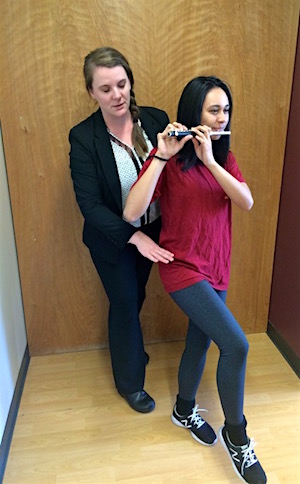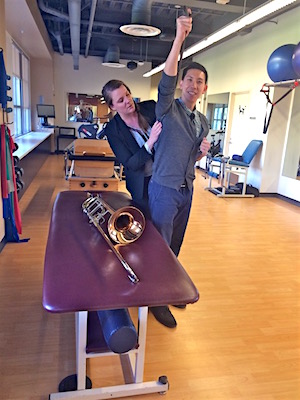Preventing injury for instrumental musicians should be high on the list of priorities for anyone planning to go to music school or who is already there. A high percentage of instrumental musicians have reported at least one injury and many plow through playing in pain. Common injuries include: muscular pain, shoulder impingement, tendinitis, nerve injuries (irritation from the neck or different parts of the arm and hand).
by Brittany Seits
Performing in pain can be extremely difficult. Pain is a great body indicator that something is wrong. We need to pay attention. And paying attention may mean getting help to address what’s going on.
In this article, Dr. Erin Hayden, physical therapist and instructor of Clinical Physical Therapy at the University of Southern California, offers tips on what we can do to prioritize our health as musicians and prevent pain and injury.
How can musicians avoid injuries and pain as a result of playing their instrument(s)?
“The most important preventative step is to take breaks, whether it be from practicing or playing,” says Dr. Hayden. “Imagine training for a marathon. You wouldn’t go from running 13 miles to running 26 miles overnight.” So if you have a big audition, concert, or festival coming up, don’t try and train for it overnight!”
Another great preventative measure is exercise. According to Hayden, “Cardiovascular exercise and moving in general are important. Especially for musicians who spend a lot of time sitting. Or if you’re standing and you stand in one position. We’re not designed to be in a static position.”
Hayden suggests doing “whatever you like, as far as walking or jogging or those same sorts of cardiovascular exercises. From an athletic perspective: athletes in the off-season will cross train. So from a music perspective, when you’re not in juries or auditions or those types of things aren’t coming up, it’s a great time to do other activities beside the repetitive positions and motions you do when you’re practicing.”
When to take a break?
“As far as intensive practice, try spreading the practice sessions out throughout the day,” Hayden suggests. She also recommends taking a break after about 45 minutes of practicing, when possible.
Musicians often struggle with tendinitis. What can be done to prevent this?
“Most of the time, the tendons involved are getting overused. Some of that you can’t help. It’s just the nature of how you hold your instrument or what particular muscles are working for playing particular instruments.
“But if you know that you’re going to work certain muscles a lot because of the nature of what you’re playing, and those muscles are going to get that repetitive use, you need to make sure that, as much as possible, you don’t overuse those muscles during other activities.
“Stretch those muscles out. Keep the different body joints in a neutral position if possible.”
For example, to prevent wrist tendinitis, keep your wrist in a straight position when you’re not playing your instrument, instead of having it extremely bent or flexed. This will help alleviate the extra stress you’re putting on the tendons when you’re playing.
What about strengthening?
Hayden says it’s important to strengthen other muscles: your core, upper back, and shoulders, to help support the areas of your body that you use more when you’re playing – like your wrist and forearm.
Imagine a tree trunk. A large tree in a windstorm is not going to blow over because it’s so strong. “But if you have a tiny little aspen,” she says, “it’s going to tip over in the same storm. If you have good core strength, and a strong upper back and shoulders, those are going to provide you with the support that you need for other muscles when you move and hold those positions when you’re playing.
“For a lot of instrumentalists, it’s about the shoulder and upper back strength. If you think about pianists moving up and down the keyboard, it’s a lot of work! So you want to have good core stability to be able to do that.”
When watching videos of practice sessions and performances, what can musicians look for?
Hayden suggests you ask yourself:
- Do I have any excessive tension? Where is that tension showing up? In my shoulders? Hands?
- Do I make any extraneous movements? Do I move too much or too little?
What should an injured musician do?
“Even if you’re not sure what to do, at least acknowledge that you have pain and pay attention to it, says Hayden.” “See whether it changes, especially if it starts to increase. We’ve all been there where we think, ‘Yea, it’s no big deal, it’ll go away!’ But at least be aware so that you can pay attention to whether it gets any worse.”
It’s especially important for younger musicians to tell their parents or teachers when they experience pain. According to Hayden, “Parents and teachers can usually offer a great deal of help. Teachers can probably notice a change in their student’s technique or their style, and they can usually be a great help in addressing those changes.”
Brittany Seits is a freelance bassoonist in Southern California and is also the Associate Director of Undergraduate Admission for the USC Thornton School of Music.




bola
Thank you!!!!!! Just what i’ve been wanting to know